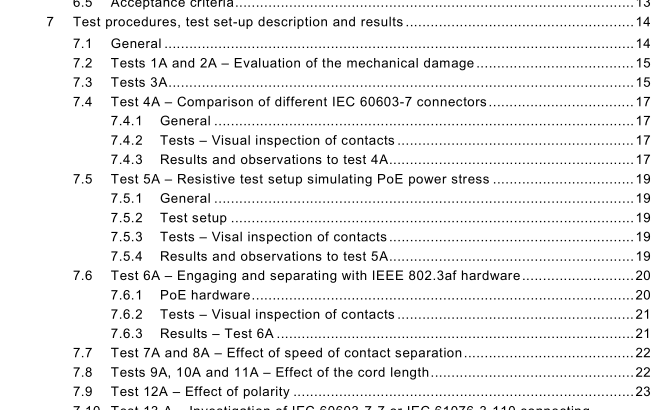IEC TR 62652:2010 pdf download – Effects of engaging and separating under electrical load on connector interfaces in cabling used to support IEEE 802.3af (power-over-ethernet) applications
4 General
This Technical Report summarizes information on the effects of engaging and separating under electrical load on the connecting hardware in cabling used to support IEEE 802.3af (Power-over-Ethernet (PoE)) applications. It is intended to make the industry aware of possible problems utilizing modular connectors in applications with increasing power levels and to encourage further investigation of the effects of the connector engaging under electrical load. This report also includes information regarding test procedures and test results.
It is not the intention of this report to recommend any test procedure or specify requirements (to be utilized in order to evaluate the connecting hardware) for connectors in cabling used to support IEEE 802.3af applications. The tests were conducted using fixed and free connectors made by US, European and Asian- Pacific suppliers. The evaluation utilized several test procedures and took place at test facilities located in the USA and Switzerland.
The bulk low level contact resistance was used as a criterion in measuring the effects of engaging cycles under the electrical load on connector durability. In some cases the electrical load was applied for the separating cycles only, in other cases the electrical load was used in both engaging and separating. The electrical load power exceeded the corresponding requirements of the IEEE 802.3af standard.
5 Telecommunications industry information With the advent of generic cabling used in the telecommunication industry, connectors are now used for a multitude of applications. In the past the great majority of such applications all were of a low power level: 4 W or less. The development of the IEEE 802.3af (Power over Ethernet (PoE)) standard changed the situation.
This application requires transmitting power of up to 1 5 W over the connectors with a nominal voltage of 48 V dc . And already new IEEE projects are under way to increase the transmitted power level up to 40 W. Different telecommunication connectors subject to the ISO/IEC standards can be used in IEEE 802.3af applications. Some of the connectors used in this study are illustrated in Figures 1 and 2. Figure 1 shows a connector according to IEC 60603-7 which is typically used for applications up to 500 MHz. Figure 2 illustrates a connector according to IEC 60603-7-7 or IEC 61 076-3-1 1 0 which is typically used for applications up to 1 000 MHz.
While transmitting some power over engaged connectors is within the specification for continuous current, the problem starts when the plug is removed / disconnected under electrical load. The breaking of a live contact produces discharges that may damage the surfaces on the connector contacts.
Different factors that could affect the connector interfaces were evaluated, including: power levels from 1 0 W to 20 W, cable length from 2 m to 1 00 m, the electrical load polarity, and speed of disconnect. The report includes observations based on the visual inspection prior and after multiple engaging cycles and the temperature and humidity conditioning. The report contains a proposal for additional future testing.
6 Technical information
6.1 Electrical discharges The process of connector engaging and separating causes mechanical damage to the surface of the interface. Such damage could be accelerated or accentuated by the electrical potential between a plug and jack if the electrical load is present during the engaging cycle. In general, there are two such phenomena: corona discharge and spark discharge. The corona discharge is caused by ionized gas in the presence of an electrical field with a high potential gradient. It is a time-dependent process, which may cause erosion, pitted surface and multiple but shallow craters. There are two distinct types of corona – positive and negative. For IEC 60603-7 type connectors in a IEEE 802.3af environment corona discharge may not be relevant, since there are no long term, high potential gradients present.
